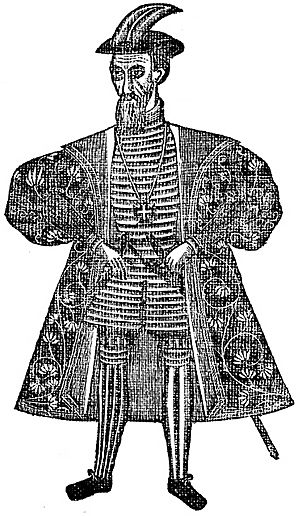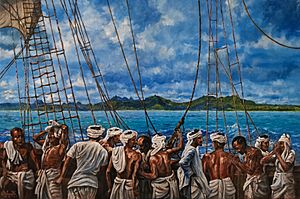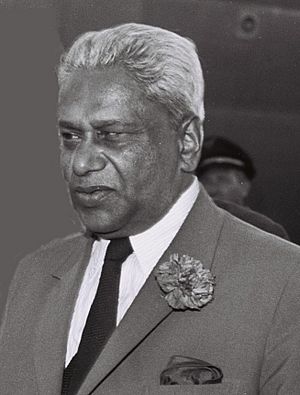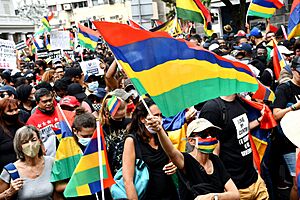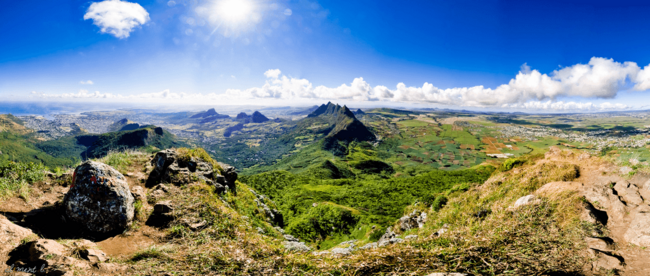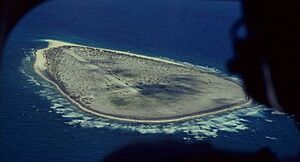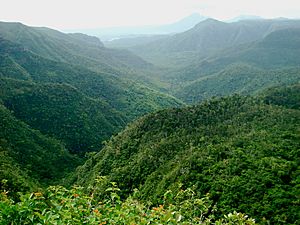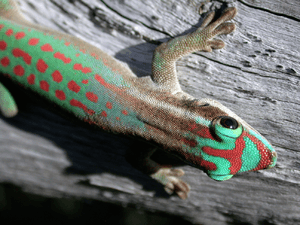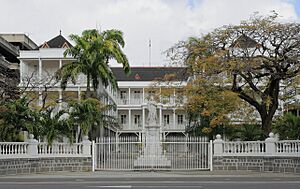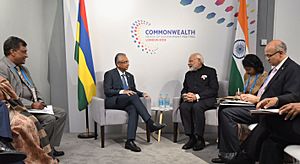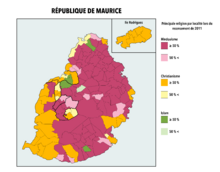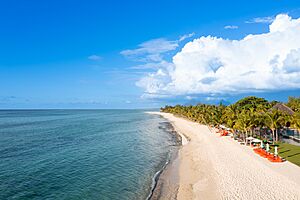Mauritius facts for kids
Quick facts for kids
Republic of Mauritius
|
|
|---|---|
|
|
|
|
Anthem: "Motherland"
|
|
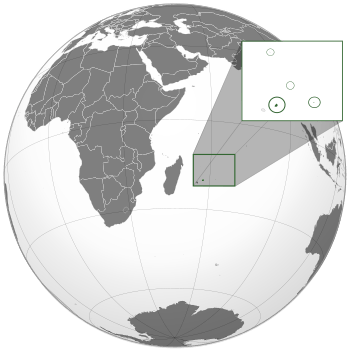
Islands of the Republic of Mauritius
|
|
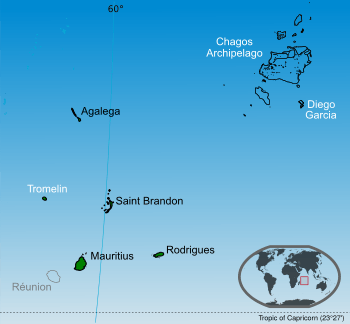
* Islands of Mauritius labelled in black.
* Tromelin Island (part of the French Southern and Antarctic Lands, claimed by Mauritius). * The Chagos Archipelago (the British Indian Ocean Territory) are set to be transferred to Mauritius in 2025. |
|
| Capital and largest city
|
Port Louis 20°12′S 57°30′E / 20.2°S 57.5°E |
| Official languages | None (de jure) (de facto) |
| Lingua franca | Mauritian Creole |
| Language spoken at home (2022) |
|
| Ethnic groups |
|
| Religion
(2022)
|
|
| Demonym(s) | Mauritian |
| Government | Unitary parliamentary republic |
| Dharam Gokhool | |
| Robert Hungley | |
| Navin Ramgoolam | |
| Legislature | National Assembly |
| Independence
from the United Kingdom
|
|
|
• Constitution of Mauritius
|
12 March 1968 |
|
• Republic
|
12 March 1992 |
| Area | |
|
• Total
|
2,040 km2 (790 sq mi) (169th) |
|
• Water (%)
|
0.07 |
| Population | |
|
• 2022 census
|
1,235,260 |
|
• Density
|
605.5/km2 (1,568.2/sq mi) |
| GDP (PPP) | 2025 estimate |
|
• Total
|
|
|
• Per capita
|
|
| GDP (nominal) | 2025 estimate |
|
• Total
|
|
|
• Per capita
|
|
| Gini (2017) | 36.8 medium |
| HDI (2023) | very high · 73rd |
| Currency | Mauritian rupee (MUR) |
| Time zone | UTC+4 (MUT) |
| Date format | dd/mm/yyyy (AD) |
| Driving side | left |
| Calling code | +230 |
| ISO 3166 code | MU |
| Internet TLD | .mu |
Mauritius, officially the Republic of Mauritius, is an island country in the Indian Ocean. It is about 2,000 kilometers (1,240 miles) off the southeastern coast of East Africa, east of Madagascar. The country includes the main island of Mauritius, plus Rodrigues, Agaléga, and St. Brandon.
The islands of Mauritius and Rodrigues are part of the Mascarene Islands. The main island of Mauritius is where most people live. Its capital and largest city is Port Louis. The country covers 2,040 square kilometers (787 square miles). It has a large exclusive economic zone of about 2 million square kilometers (772,000 square miles).
Historians think Arab sailors might have found the island around 975 AD. They may have named it Dina Arobi. Portuguese sailors visited in 1507. In 1598, a Dutch fleet took over the island. They named it Mauritius after Maurice, Prince of Orange. The Dutch tried to settle there to use the ebony forests and grow sugar. They also brought slaves from Madagascar.
In 1715, the French took control and renamed the island "Isle de France". In 1810, the United Kingdom took the island. The Treaty of Paris officially gave Mauritius and its nearby islands to the UK. Mauritius became a major sugar-producing colony for the British Empire. It remained a sugar-based colony until it became independent in 1968. In 1992, Mauritius became a republic, changing from a monarchy to having a president.
In 1965, the UK separated the Chagos Archipelago from Mauritius. They formed the British Indian Ocean Territory (BIOT). The people living there were forced to leave. The largest island, Diego Garcia, was leased to the United States for a military base. The International Court of Justice has said the Chagos Islands should be returned to Mauritius. A 2025 agreement confirmed this transfer of sovereignty.
Mauritius has a mix of people from different backgrounds. This is because of its location and history. It is the only country in Africa where Hinduism is the main religion. Most people are of Indian origin, with many Creole, Chinese, and French minorities. Mauritius has a government like the British Westminster parliamentary system. It is known for its economic and political freedom. The country offers free universal health care, free education up to university, and free public transport for students, seniors, and disabled people. Mauritius is often called the most peaceful country in Africa.
Mauritius is famous for its unique plants and animals. Many species are found only there. The dodo bird, which could not fly, lived only on the main island. It became extinct soon after people settled there. Other unique animals, like the echo parakeet and pink pigeon, are still alive. People are working hard to protect them.
Contents
The Name of Mauritius
The first map showing Mauritius was the 1502 Cantino planisphere. On this map, Mauritius was called Dina Arobi. In 1507, Portuguese sailors visited the island. They named it Ilha do Cisne (Island of the Swan).
In 1598, a Dutch group landed at Grand Port. They named the island Mauritius to honor Maurice, Prince of Orange. Later, when France took over, they renamed it "Isle de France". In 1810, the British took control during the Napoleonic Wars. The island's name went back to Mauritius. In French, it is called Maurice or Île Maurice. In Mauritian Creole, it is Moris.
History of Mauritius
Early History
Mauritius was not inhabited before Arab sailors visited it around the end of the 10th century. The name Dina Arobi is linked to these early Arab explorers.
The Treaty of Tordesillas gave Portugal the right to explore this part of the world. In 1507, Portuguese sailors came to the empty island. They used it as a visiting spot. Diogo Fernandes Pereira was the first European known to land there. He called it "Ilha do Cisne" (Island of the Swan). The Portuguese did not stay long. The Mascarene Islands were named after Pedro Mascarenhas after his visit in 1512. Rodrigues Island was named after explorer Diogo Rodrigues in 1528.
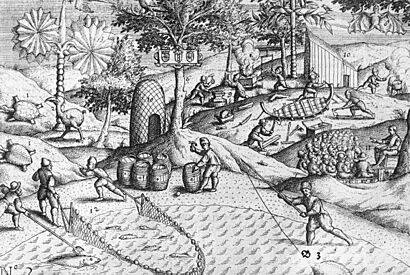
In 1598, a Dutch group led by Admiral Wybrand Van Warwyck landed at Grand Port. They named the island "Mauritius" after Maurice, Prince of Orange. The Dutch settled in 1638. They cut down ebony trees and brought sugar cane, farm animals, and deer. The famous Dutch explorer Abel Tasman started his journey to find the Great Southern Land from here. He mapped parts of Tasmania, New Zealand, and New Guinea.
The first Dutch settlement lasted 20 years. In 1639, the Dutch East India Company brought enslaved people from Madagascar. They cut ebony trees and worked on tobacco and sugar cane farms. The Dutch tried to build a lasting colony several times. But it never made enough money, so they left Mauritius in 1710.
French Rule (1715–1810)
France already controlled nearby Réunion. In 1715, France took over Mauritius and renamed it "Isle de France". In 1723, the Code Noir was set up. This law controlled slavery and treated enslaved people as property.
When French governor Bertrand-François Mahé de La Bourdonnais arrived in 1735, the economy grew. It was based on sugar production. He made Port Louis a naval base and a place for building ships. Many buildings from his time are still standing. These include parts of Government House and the Line Barracks.
During French rule, many enslaved people were brought from Africa and Madagascar. The island's population grew from 15,000 to 49,000 in 30 years. By the early 1800s, there were 60,000 enslaved people on the island. In 1729, Indians from Pondicherry, India, also arrived.
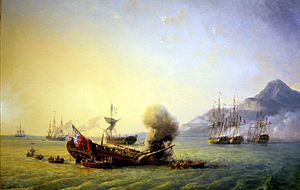
From 1767 to 1810, French government officials controlled the island. During the Napoleonic Wars, Mauritius became a base for French privateers. These ships attacked British trading vessels. In 1810, the Royal Navy captured the island. The French gave up on December 3, 1810. The British allowed settlers to keep their land, property, and use French language and laws. The island's name changed back to Mauritius.
British Rule (1810–1968)
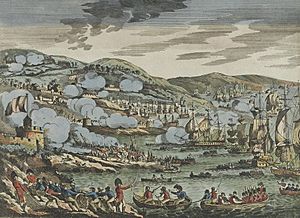
British rule brought quick social and economic changes. Slavery was slowly ended after 1833. Plantation owners received money for losing their enslaved workers. This greatly changed Mauritius's society and economy.
To replace the enslaved workers, many indentured laborers were brought from India. Between 1834 and 1921, about half a million Indian laborers came to the island. They worked on sugar farms, in factories, and on construction sites. Aapravasi Ghat in Port Louis was a main entry point for these workers. It is now a UNESCO site.
In 1885, a new constitution was introduced. It allowed some people to vote for elected positions. However, voting was mostly limited to the wealthy French and Indian elite. In 1886, Gnanadicarayen Arlanda became the first Indo-Mauritian member of the ruling council.
The 1910s saw political changes. A growing middle class of doctors, lawyers, and teachers challenged the power of sugar landowners. Eugène Laurent led a group asking for more people to vote. In 1911, there were riots in Port Louis.
World War I (1914–1918) brought prosperity to Mauritius because sugar prices went up. After the war, sugar prices dropped, and many sugar estates closed.
In 1936, the Labour Party was formed by Maurice Curé. It worked to improve conditions for workers. Strikes in 1937 led to reforms and allowed labor unions. The first Labour Day celebration was in 1938.
During World War II (1939–1945), life was hard. Prices rose, but wages did not. In 1943, police fired on striking workers at Belle Vue Harel Sugar Estate, killing four. This event is known as the 1943 Belle Vue Harel Massacre.
After a new constitution in 1947, general elections were held in 1948. For the first time, all adults who could write their name in one of the island's 19 languages could vote. Guy Rozemont's Labour Party won most seats. In 1948, Emilienne Rochecouste became the first woman elected to the Legislative Council.
More constitutional changes happened in the 1950s. In 1959, everyone aged 21 and over could vote. The Labour Party, led by Sir Seewoosagur Ramgoolam, won again.
In 1965, racial riots broke out in some villages. A state of emergency was declared.
Independence and Republic (1968–Present)
In 1965, Britain decided to grant independence to its colonies. The Chagos Archipelago was separated from Mauritius to form the British Indian Ocean Territory (BIOT). A general election in 1967 led to the Independence Party winning. In January 1968, riots happened in Port Louis, killing 25 people.
Mauritius became independent on March 12, 1968. Sir Seewoosagur Ramgoolam became the first prime minister. Queen Elizabeth II remained the head of state as Queen of Mauritius.
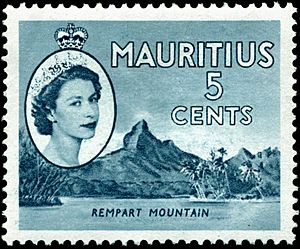
In 1969, the opposition party, Mauritian Militant Movement (MMM), was formed. Strikes in 1971 led to a state of emergency. Civil liberties were limited, and some MMM members were jailed.
In 1973, Mauritius became the first African country to be free from malaria.
A student protest in 1975 led to the voting age being lowered to 18. This aimed to help young people feel more included.
In 1982, an MMM-PSM government was elected. However, disagreements led to the government splitting up. New elections in 1983 brought a new coalition to power.
The 1980s saw growth in industries like textiles and tourism. New hotels opened, and the stock exchange began in 1989.
On March 12, 1992, Mauritius became a republic within the Commonwealth of Nations. The monarch was no longer the head of state. The last Governor-General, Sir Veerasamy Ringadoo, became the first President. Political power stayed with the prime minister.
In 1995, Navin Ramgoolam became prime minister. In 1999, there were civil unrest and riots. A commission looked into the causes of poverty.
Sir Anerood Jugnauth returned as prime minister in 2000. In 2002, Rodrigues island became self-governing. In 2003, Paul Bérenger became prime minister, and Sir Anerood Jugnauth became president. Bérenger was the first prime minister of French-Mauritian background after independence.
Navin Ramgoolam became prime minister again in 2005 and 2010. In 2014, Anerood Jugnauth became prime minister again. In 2017, he resigned, and his son, Pravind Jugnauth, became prime minister.
In 2018, President Ameenah Gurib-Fakim resigned. The current president is Prithvirajsing Roopun, who started in December 2019.
In November 2019, Pravind Jugnauth's party won the general elections. He started a new five-year term.
In July 2020, a ship called MV Wakashio ran aground. It leaked oil into a lagoon, causing a major environmental disaster.
In November 2024, the opposition coalition, Alliance du Changement, won the general election. Its leader, former prime minister Navin Ramgoolam, became the new prime minister.
Geography of Mauritius
Mauritius has a total land area of 2,040 square kilometers (787 square miles). It is the 170th largest country by size. The Republic of Mauritius includes the main island and several smaller islands. Its exclusive economic zone covers about 2.3 million square kilometers (888,000 square miles) of the Indian Ocean.
Mauritius Island
Mauritius Island is about 2,000 kilometers (1,240 miles) off Africa's southeast coast. It is 65 kilometers (40 miles) long and 45 kilometers (28 miles) wide. Its land area is 1,864.8 square kilometers (720 square miles). The island has over 150 kilometers (93 miles) of white sandy beaches. The lagoons are protected by the world's third-largest coral reef.
Near the coast are about 49 uninhabited islands and islets. Many of these are natural reserves for endangered species. Mauritius Island was formed by volcanoes about 8 million years ago. It is part of the Mascarene Islands. These islands are no longer active volcanoes. Mauritius has mountains from 300 to 800 meters (980 to 2,620 feet) high. The highest point is Piton de la Petite Rivière Noire at 828 meters (2,717 feet). Many streams and rivers flow across the island.
Rodrigues Island
The island of Rodrigues is 560 kilometers (348 miles) east of Mauritius. It covers 108 square kilometers (42 square miles). Rodrigues is a hilly volcanic island. Its highest peak is Mont Limon at 398 meters (1,306 feet). It also has a coral reef. In 2019, Rodrigues had about 43,371 people.
Chagos Archipelago
The Chagos Archipelago is about 2,200 kilometers (1,367 miles) northeast of Mauritius. It is made up of atolls and islands. The islands were transferred to Mauritius in 2025. However, Diego Garcia remains under British control on a long-term lease.
The Chagos Archipelago includes Peros Banhos, the Salomon Islands, and Nelsons Island to the north. To the southwest are The Three Brothers, Eagle Islands, Egmont Islands, and Danger Island. Diego Garcia is in the southeast. In 2016, about 8,700 Chagossians lived in Mauritius.
St. Brandon
St. Brandon, also called the Cargados Carajos shoals, is 402 kilometers (250 miles) northeast of Mauritius Island. It is an archipelago with 28 to 40 islands, depending on the season. In 2008, a court confirmed that the Raphaël Fishing Company holds rights to 13 of these islands. In 2002, UNESCO considered St. Brandon for a World Heritage Site. In May 2024, the Saint Brandon Conservation Trust was launched to protect the area.
Agaléga Islands
The two islands of Agaléga are about 1,000 kilometers (620 miles) north of Mauritius. North Island is 12.5 kilometers (7.8 miles) long and 1.5 kilometers (0.93 miles) wide. South Island is 7 by 4.5 kilometers (4.3 by 2.8 miles). The total area is 26 square kilometers (10 square miles). In 2019, Agaléga and St. Brandon had about 274 people.
Tromelin Island
Tromelin Island is 430 kilometers (267 miles) northwest of Mauritius. Mauritius claims this island, but France controls it.
When France gave Mauritius to Britain in 1814, the treaty mentioned "Isle de France and its dependencies, namely Rodrigues and the Seychelles". Mauritius argues that Tromelin was a dependency of Isle de France and should have been included. Other islands like Agaléga and St. Brandon were not named but became British. British officials in Mauritius also managed Tromelin for many years. A co-management agreement was made in 2010 but has not been finalized.
Chagos Archipelago Dispute
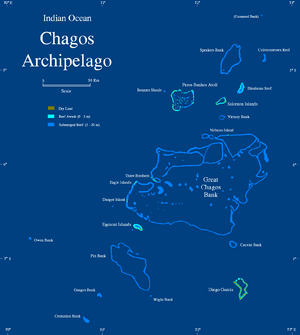
Mauritius has long wanted control over the Chagos Archipelago. Chagos was part of Mauritius since the 1700s. All islands of the French colony of Isle de France were given to the British in 1810.
In 1965, the UK separated the Chagos Archipelago from Mauritius. They also took islands from the Seychelles. This created the British Indian Ocean Territory. The UK leased Diego Garcia to the United States for a military base. This lease was extended until 2036.
Mauritius says separating its territory before independence was against United Nations rules. It claims Chagos is part of Mauritius. Between 1968 and 1973, British officials forced over 1,000 Chagossians to leave. They moved them to Mauritius and the Seychelles. The UK said there was no "permanent population" in Chagos. Chagossians have been fighting to return to their homes.
In 2019, the International Court of Justice said the UK should end its control of the Chagos Archipelago quickly. They said the separation in 1965 was not based on the people's free choice. The UN General Assembly also voted in 2019 that Chagos is part of Mauritius. It asked the UK to withdraw within six months. While this vote was not legally binding, it showed world opinion.
On October 3, 2024, the UK and Mauritian governments announced that the archipelago's sovereignty would be transferred to Mauritius. Diego Garcia, with its military base, was the only exception. It will be leased back to the UK for at least 99 years. The transfer agreement was signed on May 22, 2025.
Environment and Climate
Mauritius has a tropical climate. It has a warm, humid summer from November to April and a cooler, dry winter from June to September. The temperature difference between seasons is small. The warmest months are January and February, and the coolest are July and August. Rainfall is higher in summer. Tropical cyclones can happen between January and March, bringing heavy rain.
In July 2020, Prime Minister Pravind Jugnauth declared an environmental emergency after the MV Wakashio oil spill. This spill threatened many species.
Mauritius is affected by climate change. It faces rising temperatures, sea levels, and more extreme weather. This includes stronger cyclones, droughts, and floods. Coastal erosion also threatens the island. Mauritius plans to cut emissions by 40% by 2030. It aims for net zero by 2070.
Biodiversity
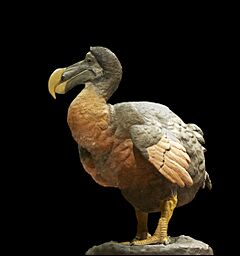
Mauritius has some of the world's rarest plants and animals. However, human settlement and new species have threatened them. Before people arrived in 1507, there were no land mammals. This allowed unique flightless birds and large reptiles to evolve. The arrival of humans led to habitat destruction and the loss of many species. The extinction of the flightless dodo bird, unique to Mauritius, is a famous example. The dodo is on the national coat of arms of Mauritius.
Less than 2% of the original native forest remains. It is mostly in Black River Gorges National Park. Over 100 species have become extinct, and many more are threatened. Conservation efforts began in the 1980s to protect endangered birds and plants.
The Mauritian flying fox is the only mammal unique to the island. Its population has been threatened by government-approved culling since 2015. This was due to concerns about fruit plantations.
Government and Politics
Mauritius is a parliamentary democratic republic. The President is the head of state, and the Prime Minister is the head of government. Mauritius has many political parties. The government exercises executive power. The National Assembly and the government share legislative power.
The National Assembly has 70 members. 62 are elected for four-year terms. Eight additional members, called "best losers," are appointed. This ensures that ethnic and religious minorities are fairly represented. The president is elected by Parliament for a five-year term.
Mauritius Island is divided into 20 areas, each electing three members. Rodrigues Island is one area, electing two members. After an election, the Electoral Supervisory Commission can add up to eight members. This helps balance ethnic representation.
The party or alliance that wins most seats forms the government. Its leader becomes the Prime Minister. The Prime Minister chooses the Cabinet from elected members. The party with the second largest group of representatives forms the Official Opposition.
Mauritius is a democracy with elections every five years. The most recent National Assembly Election was on November 7, 2019. Elections are usually a contest between two main party groups.
In 2018, Mauritius ranked first in good governance in Africa. In 2023, the Economist Intelligence Unit ranked Mauritius 20th worldwide for democracy. It is the only African country with "full democracy" on that list.
| Office held | Office holder | Incumbency |
|---|---|---|
| President | Dharam Gokhool | 6 December 2024 |
| Prime Minister | Navin Ramgoolam | 12 November 2024 |
| Vice President | Jean Robert Yvan Hungley | 6 December 2024 |
| Deputy Prime Minister | Paul Bérenger | 12 November 2024 |
| Chief Justice | Rehana Mungly-Gulbul | 18 November 2021 |
| Speaker of the National Assembly | Shirin Aumeeruddy-Cziffra | 29 November 2024 |
| Leader of the Opposition | Joe Lesjongard | 15 November 2024 |
Administrative Divisions
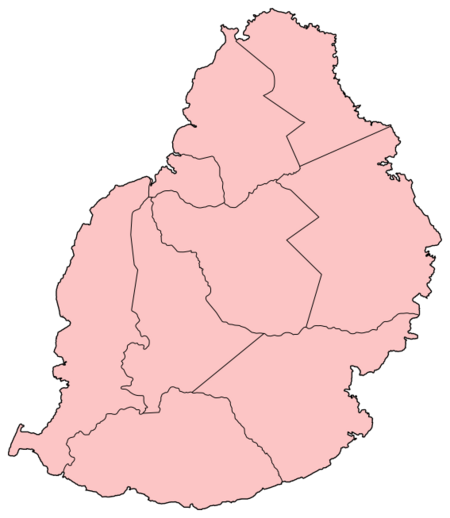
Noire
du
Rempart
Wilhems
Mauritius has one main administrative division: the Outer Islands of Mauritius. This includes Mauritius Island and several smaller islands.
The island groups are:
- Island of Mauritius
- Rodrigues
- Saint Brandon
- Agaléga
Mauritius Island is divided into nine districts.
Military and Security
All military, police, and security duties in Mauritius are handled by about 10,000 people. The National Police Force has 8,000 members and handles law enforcement. The Special Mobile Force (SMF) and the National Coast Guard are paramilitary units. They are made up of police officers. Mauritius also has a special operations military unit called 'GIPM' for high-risk situations.
Foreign Relations
Mauritius has strong relationships with countries in Africa, America, Asia, Europe, and Oceania. It has close ties with African states, especially South Africa. Mauritian businesses are growing in African markets. Because of its history, Mauritius has strong links with the European Union, especially France. Relations with India are also very strong.
Mauritius is a member of the United Nations, the World Trade Organization, the African Union, the Commonwealth of Nations, and other international groups.
Legal System
Mauritius has a mix of English common law and French civil law. The Constitution of Mauritius separates power among the government branches. It protects people's basic rights and freedoms. Mauritius has a two-level court system: the Supreme Court and lower courts. The Judicial Committee of the Privy Council in the UK is the final court of appeal for Mauritius.
Population and People

In 2022, Mauritius had a population of 1,235,260 people. The island of Mauritius had 1,191,280 people, and Rodrigues island had 43,650. Agalega island had 330 people. Mauritius has the second highest population density in Africa. In 2022, the average age was 38 years. The number of children under 15 decreased, while the number of people aged 60 and over increased.
Mauritius is a multiethnic society. Its people come from Indian, African, Chinese, and European (mostly French) backgrounds. The constitution recognizes four main communities: Hindus, General Population (mostly Creole), Muslims, and Sino-Mauritians.
Religions in Mauritius
Religion in Mauritius (2022) Hinduism (47.87%) Christianity (32.29%) Islam (18.24%) No Religion (0.63%) Other/Not stated (0.97%)
According to the 2022 census, 47.87% of Mauritians are Hindu. 32.29% are Christian, mostly Catholic. 18.24% follow Islam. Other religions make up 0.86%. About 0.63% said they had no religion.
The constitution allows freedom of religion. Major religious groups receive some government support. Public holidays include Hindu, Christian, and Muslim festivals.
Languages in Mauritius
The Mauritian constitution does not name an official language. However, English and French are used for government, courts, and business. The constitution is in English, but some laws are in French. Mauritian money has writing in Latin, Tamil, and Devanagari scripts.
Most Mauritians speak several languages. Mauritian Creole is the main language for most people. Many also speak English and French. They switch languages depending on the situation. French and English are used in schools and jobs. Asian languages are used for music, religion, and culture.
Mauritian Creole is based on French with other influences. Different Creole languages are spoken on the islands: Mauritian Creole, Rodriguan Creole, Agalega Creole, and Chagossian Creole. Other languages like Bhojpuri, Chinese, Hindi, Marathi, Sanskrit, Tamil, Telugu, and Urdu are also recognized. Bhojpuri is less common now than it used to be.
Students must learn English and French. They can also choose an Asian language or Mauritian Creole. Most public schools teach in English, while private schools often use French.
Education
Mauritius has pre-primary, primary, secondary, and university education. The government provides free education from pre-primary to university. In 2013, the government spent about 13% of its total budget on education. Since 2017, the education system has changed. The Certificate of Primary Education (CPE) was removed.
Exams like O-Level and A-Level are given by Cambridge International Examinations. The main public universities are the University of Mauritius and the University of Technology. These and other colleges are free for students since 2019.
In 2022, 91.9% of adults could read and write. About 8.8% of the population had a university degree. In 2024, Mauritius ranked 55th in the Global Innovation Index, first in Africa.
Economy
Mauritius is often called Africa's most developed country. Since gaining independence in 1968, it has grown from a farming-based economy to a high-income economy. Its main industries are tourism, textiles, sugar, and financial services. This economic growth is sometimes called "the Mauritian Miracle."
Recently, technology, seafood, hotels, property, healthcare, and renewable energy have become important. These areas attract a lot of investment. Mauritius has one of the largest exclusive economic zones in the world. The government plans to develop its marine economy.
Mauritius does not have fossil fuels. It relies on oil for most of its energy. It uses renewable sources like biomass, hydro, solar, and wind. The country aims to cut emissions by 40% by 2030. It plans to stop using coal for electricity by 2030.
Mauritius is known for its strong economy, good investment climate, and free economy. Its Gross Domestic Product (PPP) was estimated at $29.187 billion in 2018. Its GDP (PPP) per person was over $22,909, the second highest in Africa.
The World Bank classified Mauritius as a high-income economy in 2019. In 2019, Mauritius ranked 13th worldwide for ease of doing business. Challenges include relying on a few industries, brain drain, and an aging population.
Financial Services

Financial and insurance activities made up 11.1% of the country's GDP in 2018. Mauritius is becoming a hub for investing in Africa. This is because of its location, laws, and skilled workers. It has many international banks, law firms, and investment funds.
The corporate tax rate is 15% to 17%. Individual tax rates are 10% to 25%. Mauritius offers tax breaks in some areas. The country works to be transparent and fight financial crime.
Tourism
Mauritius is a popular tourist spot. Tourism is a main part of its economy. The island has a tropical climate, warm clear seas, beaches, and unique plants and animals. It also has a diverse culture. In 2019, about 1,450,000 tourists visited.
Mauritius has two UNESCO World Heritage Sites: Aapravasi Ghat and Le Morne Cultural Landscape.
Transportation
Since 2005, public buses and trains in Mauritius have been free for students, disabled people, and seniors. The Metro Express railway connects five cities and the University of Mauritius. The Port Louis harbor handles international trade and cruise ships. The Sir Seewoosagur Ramgoolam International Airport is the main international airport. It is the home base for Air Mauritius. The Plaine Corail Airport in Rodrigues connects to the main island and Réunion.
Technology and Communication
The information and communications technology (ICT) sector made up 5.7% of Mauritius's GDP in 2016. The African Network Information Centre (AFRINIC), which manages internet addresses for Africa, is based in Ebene.
Mauritius is connected to the global internet by several underwater fiber optic cables.
Culture
Art
Famous Mauritian painters include Henri Le Sidaner and Malcolm de Chazal. Gabrielle Wiehe is a well-known illustrator.
The Mauritius "Post Office" stamps were the first stamps made outside Great Britain. They are very rare and famous.
Architecture
Mauritius's unique architecture shows its history as a trade base. Styles from Dutch, French, and British settlers mixed with influences from India and East Africa. This created a special blend of designs.
Many historic buildings have been destroyed over the years. This is due to development and high land values. It is also expensive to maintain old buildings.
Literature
Mauritius is known in literature for the novel Paul et Virginie. This is a classic French love story. The dodo from Alice's Adventures in Wonderland is also linked to Mauritius.
Famous Mauritian writers include J. M. G. Le Clézio, Ananda Devi, and Nathacha Appanah. Le Clézio, who won the Nobel Prize for Literature in 2008, has Mauritian heritage.
Music
The main music styles in Mauritius are Sega and Seggae. Other popular types include Bhojpuri folk songs, Indian movie music, and classical music.
Cuisine
Mauritian cuisine mixes Indian, Creole, French, and Chinese foods. Many dishes are unique to the island. Local foods include curries, farata (like parathas), briani (like biryani), and mines frires (fried noodles). Bol renversé (upside-down bowl) and rougaille (sausage and tomato dish) are also popular. Desserts include "napolitaine" biscuits and coconut-based sweets.
Spices, lentils, pickles, and leafy vegetables are common. Street food includes dholl puri wraps, gâteau piment (chilli cakes), and chana puris.
Holidays and Festivals
Mauritius has many public holidays that mix different cultures. There are Hindu, Christian, Chinese, and Muslim festivals. There are 14 public holidays each year. New Year is celebrated for two days if it falls on a weekend. Religious holidays change dates each year, except Christmas. Other festivals like Holi and Diwali also add to the culture.
| Public holidays in Mauritius in 2023 | Date |
|---|---|
| New Year | Sunday 1 January – Monday 2 January |
| Chinese Spring Festival | Sunday 22 January |
| Abolition of Slavery | Wednesday 1 February |
| Thaipoosam Cavadee | Saturday 4 February |
| Maha Shivaratri | Saturday 18 February |
| Independence and Republic Day | Sunday 12 March |
| Ougadi | Wednesday 22 March |
| Eid-Ul-Fitr (Depending on the visibility of the moon) | Saturday 22 April |
| Labour Day | Monday 1 May |
| Ganesh Chaturthi | Wednesday 20 September |
| All Saints Day | Wednesday 1 November |
| Arrival of Indian Indentured Labourers | Thursday 2 November |
| Divali | Sunday 12 November |
| Christmas | Monday 25 December |
Sports
The most popular sport in Mauritius is football. The national team is called The Dodos or Club M. Other popular sports include cycling, table tennis, horse racing, and various water sports.
Kim le Court is a successful professional cyclist. She has won many races, including stage 8 of the 2024 Giro d'Italia Women. In 2025, she won Liege-Bastogne-Liege Femmes.
Horseracing started in 1812 at the Champ de Mars Racecourse and is still popular. Mauritius hosted the Indian Ocean Island Games in 1985, 2003, and 2019. Mauritius won its first Olympic medal in 2008 when boxer Bruno Julie won bronze.
In golf, the AfrAsia Bank Mauritius Open is part of the European Tour.
Images for kids
See also
 In Spanish: Mauricio para niños
In Spanish: Mauricio para niños




